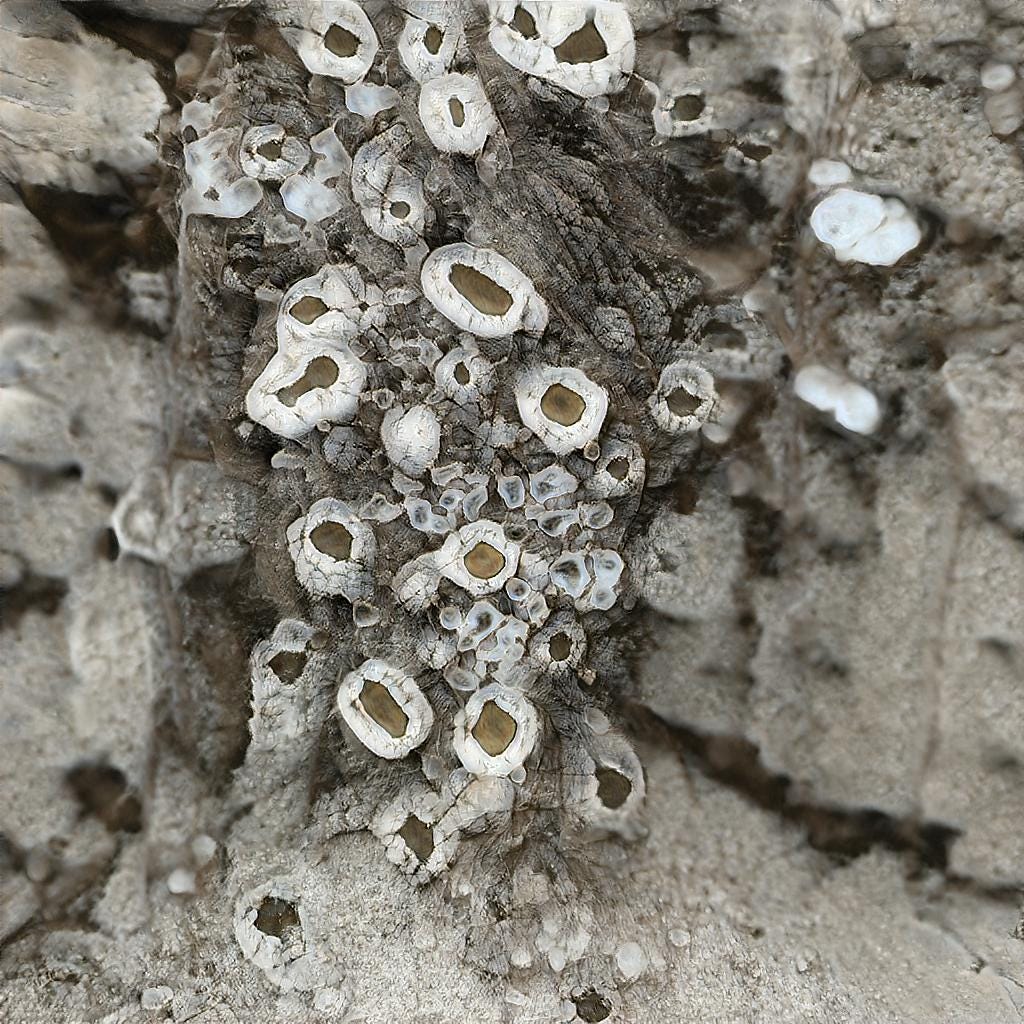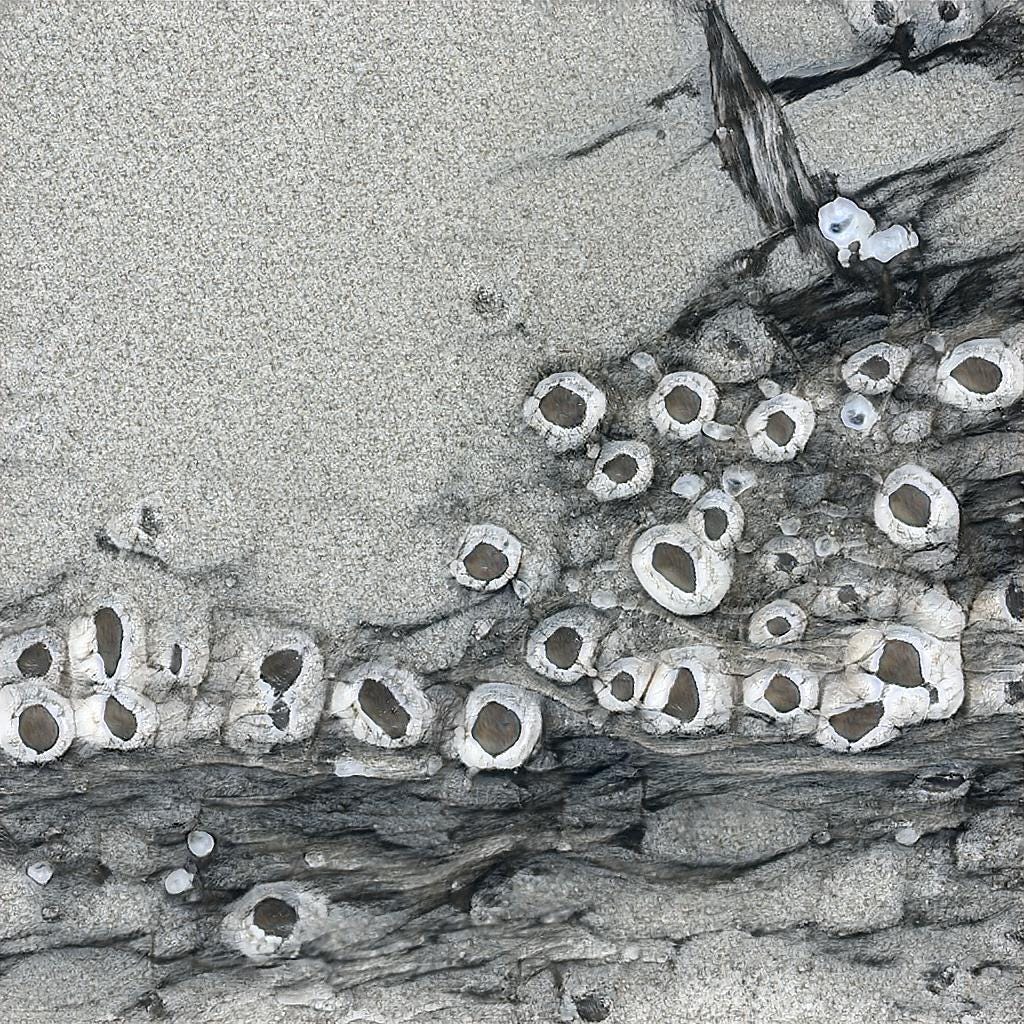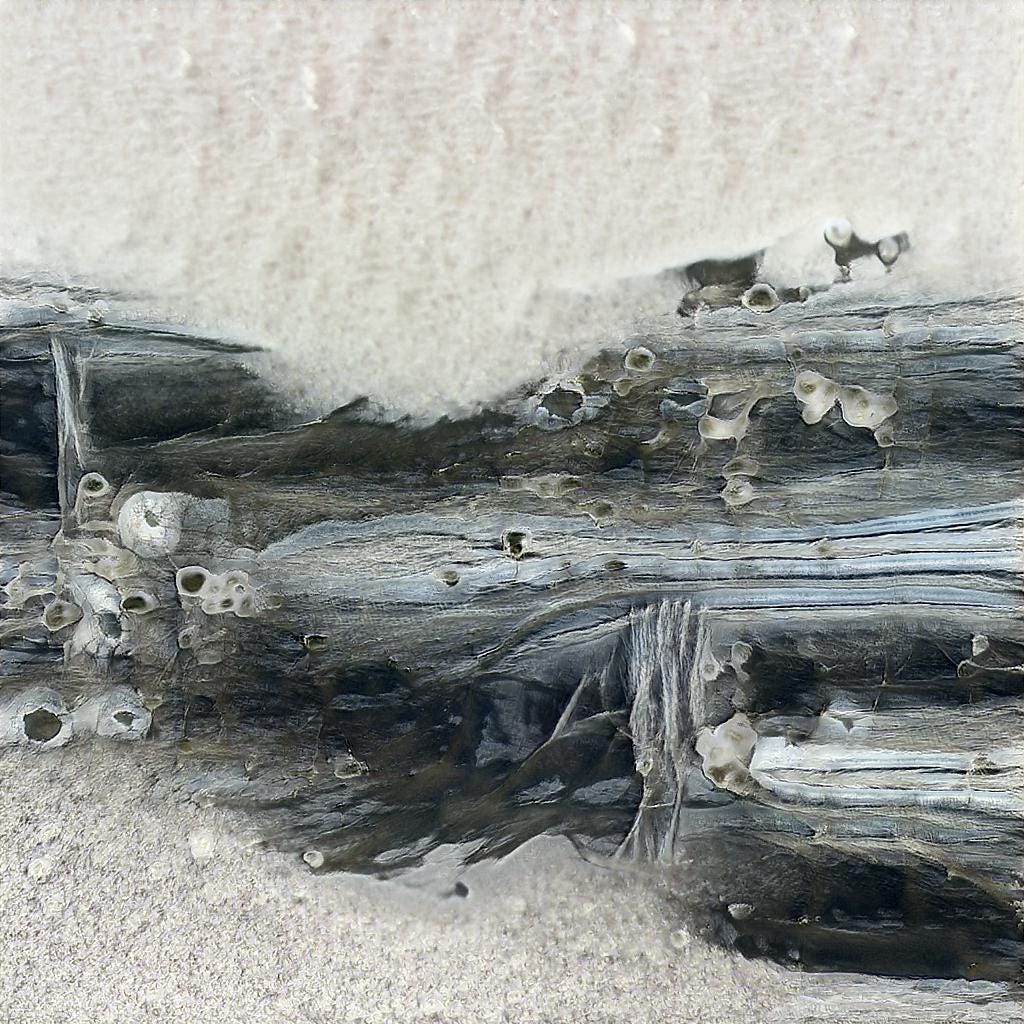Infinite Barnacle
The beach trip as eternal return

Sometime in 2021, with our time on the eastern side of Virginia coming to a close, my partner and my dog made a journey to the Chesapeake Bay. We were in the midst of what would be a nomadic and tumultuous year. We had no idea where we might live or work after this place. For that day, the sky was gray but the air was warm and the Chesapeake Bay was a reprieve from our time spent at a boarding school surrounded by rural farmland.
I had lived near water for most of my life, until leaving San Francisco for the inland space of Canberra, which had Lake Burley Griffin, but I did not see the ocean except to fly over it for 17 hours to and from there. My parents are in Maine, on the seacoast, where there is a walkway that takes you to a place where the river and the Atlantic meet.
So finding myself surrounded by slightly salty debris felt comfortable and familiar. As we walked around the empty shoreline I took photographs — hundreds of them — of the barnacles and logs and sand and kelp that washed ashore.
These photographs of the time and place would become both memories and data. It’s been useful in my thinking about the distinction between the two. The memories are fragments — my dog running ahead, splashing in the still-too-cold water. My partner looking for bald eagles in the trees through binoculars. The magic appearance of two swans.
The data was in my phone: five hundred or so photographs, taken in square formats. The artifacts of memory, maybe, or else the debris. A photograph is a kind of tracing of light into film, in digital images it is the tracing of light into data.
I have a book on the history of film, and a book on the history of the pixel. The index for “memory” in the film book says “see also: mourning.” The index for “memory” in the pixel book says “see also: frame buffers.” In either case, however, to remember images, written in light, inscribed into canvas or stone or film or 2GB SanDisks — it’s that verb, inscription, that tells us all we need to know. An inscription is a recording — an act of preservation. We might take a picture of long lived things, like mountains and stars, but these photographs record our own mortal and temporary presence in front of them.
We want to preserve that which disappears, including the intangible moment of its experience. A photograph is always intertwined with loss: “What we know that we will no longer have before us,” writes Walter Benjamin, “is what becomes an image.” For Barthes, the presence of the film as the image is inscribed into it becomes a kind of physical witness. But the “aura,” for Benjamin, is lost in reproducing the image from the plate, even in “the most perfect reproduction of a work of art,” because it “is lacking in one element: Its presence in time and space, its unique existence at the place where it happens to be.”
A photograph of the barnacles on Chesapeake Bay cannot transmit the experience of being there. We can look at an image and remember it, but it won’t transport us. It lives in my memory, not yours.

With 500 images it’s possible to teach a machine to create new pictures. You need more, so you reverse them, rotate them, zoom in or zoom out slightly, crop into quarters and then 500 becomes 2000 and 2000 becomes 10,000. But you only need about 5000, really. At that point, a machine learning model has enough information to take your memories, inscribed as information, and transform them into new data. In this case, to generate new photographs of a day in Chesapeake Bay.
The images in this post are generated from that model. It’s able to trace the inscription of barnacles and sand and wood, distributed by the rising and retreating tides off the Chesapeake Bay. It’s then able to begin tracing its own pixelated lines into the frame, producing variations of the Bay’s sand-writing into new pictures. Pictures that never existed. Arrangements that never appeared for me on the beach on that gray day at the end of the summer. But they appear for you and I now, whenever we want them. I could generate 1,000 more in an hour.
“Technology consigns the outer image of things to a long farewell, like banknotes that are bound to lose their value,” Benjamin writes. “It is then that the hand retrieves this outer cast in dreams and, even as they are slipping away, makes contact with familiar contours.”
If the memory of the place is fleeting, and the photographs — 500 of them — a static archive, then what does it mean to generate new variations of the place? To scatter barnacles in new patterns on nonexistent driftwood, to dig new holes in imaginary sand? Is it like a dream, where we recombine the familiar world into new shapes of meaning to interpret through our snoozy disarmed senses?
An infinite number of barnacles generated from a single memory. It’s grasping at that dream of eternal return in a way that a photograph, with its limits of the frame, can’t grasp in quite the same way. Nietzsche gets at it in The Gay Science:
What if some day or night a demon were to steal after you into your loneliest loneliness, and say to you, "This life as you now live it and have lived it, you will have to live once more and innumerable times more; and there will be nothing new in it, but every pain and every joy and every thought and sigh and everything unutterably small or great in your life will have to return to you, all in the same succession and sequence [...] Would you not throw yourself down and gnash your teeth and curse the demon who spoke thus? Or have you once experienced a tremendous moment when you would have answered him: "You are a god and never have I heard anything more divine."

The techno-utopians want to put our heads in vats, program dreams built on data so we can extend our lives of a lucky sixty years into an endlessly repetitive eternity, digital symbiosis moving neurons into bits, transforming the bittersweet and fleeting into the tedious and ever-present.
When I look at these images I imagine a boundary between past and present that is moving forward like a rolling cloud. The real was recorded, the data inscribed into new patterns emergent from a single context. What I see in these images is the tracing of my time spent, but interpreted and represented by an other, a not-me, seeing and looking at what I saw, and describing it back.
Benjamin had a moment of identity crisis in a portrait studio when he was ten. Surrounded by props, poses, a smile he felt wasn’t his own, the photograph would never be “him.” He describes this and gets Lacanian: his speech, as a child, is the language of another, his desires described according to the words that sounded the most like the thing he desired. The photograph the thing that tells him who is.
A machine learning model offering me new ways of remembering what I remembered — a false memory, a drift from lived experience into the jolt of simulated recognition, does the same for me as the cushions and photographer’s instructions do in the portrait studio. There they twist the subject, here they twist an object. Re-presentation of memory. Barthes says the genius of the photograph is its assurance that “someone has seen the referent, in flesh and blood, or again in person,” the “this-has-been.” In cinema, we see the “this-has-been” of the actor’s performance.
And in Generative Images, we see the “this-has-been” of the data, just as fictionalized a story as that of Benedict Cumberbatch being Sherlock Holmes and an abusive cowboy on our screens. The story told by the images in succession is reality captured and distorted, its falseness erased only by our human talent for suspending disbelief. Photographs, Berger says, are “appearances prised away from their meanings,” but perhaps the generative photograph is a meaning “prised away” from its appearance.
Which brings us, unfortunately, to Baudrillard: the generative image as a simulation of memory, a false memory. A gaslight. No separation between the false and true, the real from its artificial resurrection, everything already dead and already resurrected. Nostalgia.

Francine Dagenais has an essay, “Productive Imagination and the Bodily Suffix,” written in 2005, exploring the idea of the “Bodily Suffix” of the prosthesis. The camera lens as a prosthesis, an extension of our human capacities, allowing us, she writes, to do and see what we otherwise could not: telescopes to microscopes to images of ourselves. She also notes Giuseppe Penone’s 1970 work, To Turn One’s Own Eyes Inside Out, contact lenses coated by a reflective surface so that light could not enter the eye but that the retina was exclusively reflected. The experience was of blindness, but the imaginary prosthesis of the work was to spin back the imaginative power of observation into one’s own mind.
In the case of the generative snapshot, I think this resonates most strongly. The beach is in my mind, a memory trapped and waiting to be sprung to some hazy projection or daydream. The means through which I do this is the machine, generating and rendering new an image whose authenticity is secondary to the suggestion of the memory. A souvenir of the Eiffel Tower doesn’t represent steel with its cheap plastic molding. But it doesn’t have to.
The machine gives us a space to meet to project our memory onto its assemblages, and together we work to reimagine the memory. It is an active conversation. Same as a photograph, same as a film, same as a souvenir. Like any photograph, it grasps for eternity in a single second. It simply does it forever, instead of the once.






